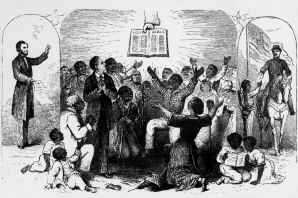| 1861 |
John C. Fremont issued a proclamation on August 30, 1861 immediately emancipating the enslaved people of Confederate supporters in Missouri. The order was revoked by President Abraham Lincoln on September 11 and Fremont was removed from command. |
| 1862 |
The Battle of Island Mound, a small skirmish that took place on October 29, 1862 in Bates County, marked the first time Black soldiers saw combat in the Civil War. The 1st Kansas Colored Volunteers fought pro-Confederate guerillas and due to their success, showed that Black soldiers could and would fight for the cause. They would be allowed to enter federal service a few weeks later. |
| 1863 |
President Abraham Lincoln’s Emancipation Proclamation went into effect on January 1, 1863, proclaiming enslaved people to be free in the portions of seceded states not in Union control. The proclamation did not affect Missouri's slaveholders. |
| 1863 |
Recruiting for the first Black Missouri regiment began at Schofield Barracks in St. Louis in June 1863. Over 300 enlisted in the First Regiment of Missouri Colored Infantry, which became the 62nd Infantry of the United States Colored Troops. Over 8,000 Black Missourians served in the Union Army. |

Harpers Weekly. Used with permission of the State Historical Society of Missouri
|
| 1863 |
President Abraham Lincoln ordered that all black men, aged twenty to forty-five, in healthy condition, be allowed to enlist in the armed forces (July 31). |
| 1865 |
Elected in the November 1864 election, delegates to the 1865 Constitutional Convention in St. Louis passed an ordinance abolishing slavery in Missouri on January 11, 1865 with only four delegates voting against it. The ordinance passed three weeks before the U.S. Congress proposed the Thirteenth Amendment to the U.S. Constitution abolishing slavery. |
| 1865 |
Missouri was the eighth state to ratify the Thirteenth Amendment to the U.S. Constitution ending slavery on February 6, 1865. The amendment went into effect on December 18, 1865. |
| 1865 |
The Missouri General Assembly passed legislation (”An Act in relation to the marital rights and children of colored persons”) on February 20, 1865 for all persons previously enslaved who cohabited as husband and wife to be married legally in front of a Justice of the Peace. If there were children as a result of the relationship, the clerk would record their names with the marriage in order to legitimize them. |
| 1865 |
The Western Sanitary Commission, a St. Louis-based relief organization for war refugees, operated a high school for African Americans. The Commission also organized classes for black soldiers at Benton Barracks. |
| 1865 |
Black Missouri leaders organized the Missouri Equal Rights League in October 1865. Considered Missouri's first Black political activist organization, League members fought for legal equality, placing emphasis on education and voting. |
| 1866 |
The Lincoln Institute (renamed Lincoln University in 1921) received its first students on September 17, 1866. The Institute was incorporated to provide education for Black students in Missouri and was founded by Black soldiers of the Civil War's 62nd and 65th Regiment Infantry of the United States Colored Troops. |
| 1867 |
Missouri was the 17th state to ratify the Fourteenth Amendment to the U.S. Constitution addressing universal citizenship rights and equal protection under the law on January 25, 1867. The amendment went into effect on July 9, 1868. |
| 1868 |
The federal Freedman's Bureau established the St. Louis branch of the National Freedmen's Savings and Trust Company. |
| 1870 |
Missouri was the 21st state to ratify the Fifteenth Amendment to the U.S. Constitution prohibiting the federal government and each state from denying a citizen the right to vote based on that citizen's "race, color, or previous condition of servitude" on January 10, 1870. The amendment went into effect on March 30, 1870. |
| 1875 |
The new Missouri Constitution provided for separate school facilities for black and white children. This forced St. Louis school board members to establish Sumner High School for African American students. |